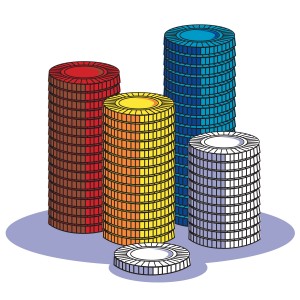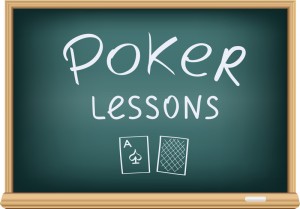Keep track of the changing stack sizes
I just completed working on the book Winning Poker Tournaments One Hand at a Time, Volume I. Other than specific concepts and strategies, this book shows the reader what it takes to think through hands at a professional level. The one thing that becomes very apparent is that top professionals are always acutely aware of their stack sizes, the stack sizes of their opponents, and these stack sizes in relation to the blinds. When I am sitting at the table, I am constantly evaluating how the stack sizes are changing throughout the tournament, and I do this following practically every hand.
Stack size is everything when it comes to tournaments.
To demonstrate this concept further, I am going to look at a common tournament situation in the big blind. The cards, the opponent, and the position of your opponent will remain the same, but the stack sizes are going to change.
Situation: The money bubble is still not quite in sight. The blinds are 300-600 with a 50 ante. You are sitting in the big blind and get dealt the Q♣ 10♥. A solid, typical player raises first in from the cutoff to 1,800, and everyone folds to you. What do you do?
Note that there is 3,150 in the pot. If your opponent has 20,000 in chips and you have 2,000 left, this is an easy decision to push all in. You are short-stacked, have a decent hand for being in the big blind, and are getting good pot odds.
If the cutoff has 2,000 in chips remaining after his raise and you have 20,000 in chips remaining, what do you do? There is 3,150 in the pot, and you have to call only 1,200. You could push all in, effectively investing 3,200 to win 5,150. You certainly are getting the pot odds to do so. Another option would be to call and then either push on the flop as a bluff or check-raise anytime you hit your hand.
When both you and your opponent are deep-stacked, you are able to play more hands, but you must play them carefully, to avoid losing all of your chips on a mediocre holding. In our same example, let’s give you and your opponent stacks of 50,000 plus. Reraising in this situation would be quite risky, as you would be building a big pot with a mediocre hand while out of position. For this reason, some players might fold to avoid a difficult situation, but you certainly can call here, hoping to hit a big hand. You both have very large stacks, so a straight or two pair could win you a very big pot. Of course, if you hit only a pair, you must play the hand carefully so that you do not build a big pot against a hand that has you dominated.
Let’s look now at some more complex situations. Assume now that you have 9,000 remaining after posting the blind and ante and your opponent has 20,000 in chips. This gives you an effective stack that is 15 times the big blind. If you were to push all in, there would now be 12,150 in the pot and your opponent would have to call 7,800, which is 1.6-1 pot odds to call. There aren’t many opponents who will be folding here, so you have very little fold equity by pushing all in. So, pushing all in isn’t very attractive. If you call a bet, you are forfeiting 13 percent of your stack to see a flop. However, you do have some options when you see the flop. You could push all in as a bluff or check-raise whenever you hit a pair. With only 9,000, it isn’t advisable to pay off 1,200 in chips and fold on the flop; if you are going to call preflop, do so with the intention of getting the rest of your chips in on the flop.
What if you have 12,000 in chips remaining? In this case, your effective stack is now 20 times the big blind. If you were to push all in, there would now be 15,150 in the pot and your opponent would have to call 10,800, which is 1.4-1 pot odds to call. You now have some significant fold equity, as your opponent will need a solid hand to make this call. Note that you are putting real pressure on your opponent, as he would be losing more than half of his stack to make this call. You might be able to get your opponent to fold hands like A-9, K-J, or 6-6, depending on your image and the type of opponent he is. If called, you still have a chance to hit your hand and win the pot.
You also could argue for a call in this spot and still be able to fold on the flop. Calling would risk 1,200 in chips with a pot of 3,150. The biggest problem with calling here and then folding is that you will be decreasing your ability to get opponents to fold future hands, as your stack is now diminished. On the other hand, when you hit the queen or 10, you will likely pick up a continuation-bet at a minimum. In this type of situation, I can accept losing to a hand that is dominating me given my short stack. In other words, I am willing to risk my chips with a mediocre hand if I hit it. Of course, there also will be some semibluff opportunities with a hand like Q-10 on the flop, so you don’t have to hit a pair every time.
What if you have 25,000 in chips and your opponent has 30,000? This gives you more than 40 big blinds. Pushing all in is now questionable, as you are risking a lot of chips with a mediocre hand. Calling here is also risky, as it will be difficult to play this hand post-flop if you hit a pair. By the time you get enough information to learn whether your hand is the best or not, you will have depleted most of your stack. In this case, I would lean toward folding against typical opponents.
What makes tournament play so interesting and exciting is that you are in a constant battle for survival. Your stack size and its relation to the blinds dictate when you might take risks and when you might play cautiously. For this reason, tournament players must become competent with short-stack play, deep-stack play, and medium-stack play. This is one of the key reasons why cash-game players often have a hard time adjusting to tournament play. You still need to look at your cards, but remember to constantly keep track of the changing stack sizes at your table.
Submit your review | |









